|
|
|
Armchair Strategist's Martial Arts Pages |
 |
Backfist strikes
| Like all things in
martial arts there is no one-only-way to do a backfist. Many
Karate/TKD clubs teach a very linear and deliberate
delivery, I personally take a more holistic approach;
interpreting the backfist as a striking surface which can
be delivered in many valid variations to suite the
situation. As a crude generalisation, Kung-fu styles tend
to have more varied and sophisticated backfisting
techniques than Karate/TKD. The first thing to get out of the way is the striking surface. Many clubs teach that this is the whole of the back of the hand -a big slap (see 'a'). Others bend the wrist back at nearly a right angle and strike with just the knuckle (see 'b'). I train that the back of the middle knuckle is the striking surface and so should hit first. It is the fact that you are hitting with this hard bony part that makes it so effective. See 'c'. |
 |
3 ways
For ease of understanding, I've divided this page into three general ways of delivering a backfist based on the way that power is developed -rather than the application or route that the strike travels. Of course, there are methods taught which do not neatly fit any division, such as the straight arm inverted backfist swing of Northern Kung-fu, but that's life.
1. Snap backfist
This is the mechanical method made famous by Bruce Lee. The fist is thrown as if on an elastic band, withdrawing immediately after contact (with a short punch through). In general terms it is the fastest but also the least powerful method -making it popular in sparring. Power is generated from the high velocity and momentary clenching of the fist on impact. This method is made more powerful if you shift forward as you deliver it and/or you are pulling your opponent onto the strike.
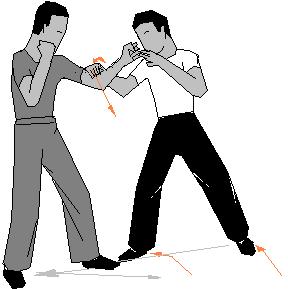 |
Example #1.1 From a dynamic fighting
situation, deflect his lead guard from the outside, with
your palm to his elbow. If practical drag it down a bit
to further open up the 'window' between his lead guard
and his face -getting in behind his guard. Variations on this can be adapted as an attack or defence. |
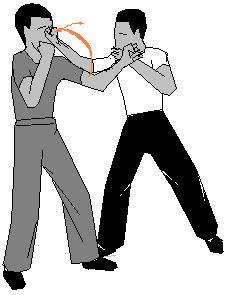 |
2. Expansive backfist
| This
method uses the velocity of the fist together with full
follow-through and hip rotation to generate power. As
such it is quite weak over short distances but can be
incredibly powerful if it travels a long distance. The
trajectory is necessarily arcing and usually horizontal. Although in theory it is relatively slow because of the distance travelled, it is in reality a very powerful and robust strike with knockdown potential. It does require distance to develop power so is only really suited to long and middle range. Perhaps the best example of an expansive backfist is a spinning backfist with full follow-through (see right). These techniques are most usefully aimed at the face. A variation can be used as a block to deflect/drag. |
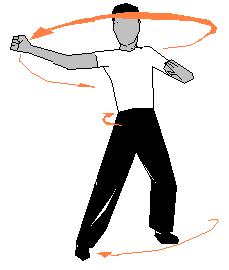 |
3. Solid backfist
This is the
'in-between' of the other two categories. It is thrown at the
opponent using the familiar distance travelled, hip rotation,
clenching of the fist on impact and velocity to develop power.
However, it is not just the fist that is tensed on impact but
also the wrist. It is most usually thrown in a vertical
trajectory (i.e. elbow down) which adds gravity and is less risky
considering that it is slower to retract given the tension in the
lower arm.
This last characteristic, whereby it is slow to retract can be a
risk but it is also useful. Whereas more often than not is wise
to retract strikes after contact to avoid being grabbed, it is
also sometimes beneficial to leave it there to obstruct/trap your
opponent.
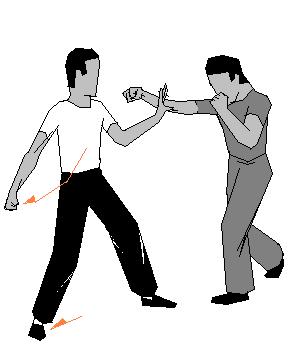 |
Example #3.1 An interesting example of an effective solid backfist is as an overhead smash. Start with a grab block with your lead hand, deflecting their opposite arm outwards. Simultaneously start the overhead backfist in a long arc. Pulling the caught arm downwards and to your outside, bring the backfist down in a smashing action. Note that it isn't swung like a windmill, the elbow is bent as it comes over, over your shoulder. Theoretically it is
easily anticipated and blocked but in practice I find it
takes most sparring partners completed by surprise. It
also has the potential to deliver a very powerful wallop
to the face. The hand can be left out after striking
forming a shield and setting up a follow-up such as a
heel kick to the groin or midsection which the opponent
cannot see coming as your fist/forearm obscure his
downward vision. |
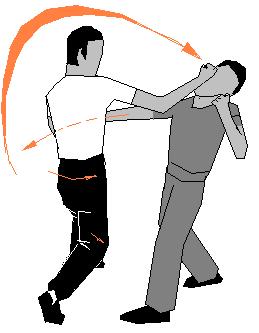 |